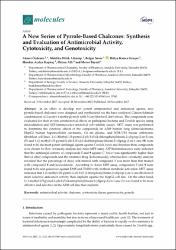| dc.contributor.author | Özdemir, Ahmet | |
| dc.contributor.author | Altıntop, Mehlika Dilek | |
| dc.contributor.author | Sever, Belgin | |
| dc.contributor.author | Karaca Gencer, Hülya | |
| dc.contributor.author | Kapkac, Handan Acelya | |
| dc.contributor.author | Atlı Eklioğlu, Özlem | |
| dc.contributor.author | Baysal, Merve | |
| dc.date.accessioned | 2019-10-19T14:44:39Z | |
| dc.date.available | 2019-10-19T14:44:39Z | |
| dc.date.issued | 2017 | |
| dc.identifier.issn | 1420-3049 | |
| dc.identifier.uri | https://dx.doi.org/10.3390/molecules22122112 | |
| dc.identifier.uri | https://hdl.handle.net/11421/13577 | |
| dc.description | WOS: 000419242400081 | en_US |
| dc.description | PubMed ID: 29189730 | en_US |
| dc.description.abstract | In an effort to develop new potent antimicrobial and anticancer agents, new pyrrole-based chalcones were designed and synthesized via the base-catalyzed Claisen-Schmidt condensation of 2-acetyl-1-methylpyrrole with 5-(aryl)furfural derivatives. The compounds were evaluated for their in vitro antimicrobial effects on pathogenic bacteria and Candida species using microdilution and ATP luminescence microbial cell viability assays. MTT assay was performed to determine the cytotoxic effects of the compounds on A549 human lung adenocarcinoma, HepG2 human hepatocellular carcinoma, C6 rat glioma, and NIH/3T3 mouse embryonic fibroblast cell lines. 1-(1-Methyl-1H-pyrrol-2-yl)-3-(5-(4-chlorophenyl)furan-2-yl)prop-2-en-1-one (7) and 1-(1-methyl-1H-pyrrol-2-yl)-3-(5-(2,5-dichlorophenyl)furan-2-yl)prop-2-en-1-one (9) were found to be the most potent antifungal agents against Candida krusei and therefore these compounds were chosen for flow cytometry analysis and Ames MPF assay. ATP bioluminescence assay indicated that the antifungal activity of compounds 7 and 9 against C. krusei was significantly higher than that of other compounds and the reference drug (ketoconazole), whereas flow cytometry analysis revealed that the percentage of dead cells treated with compound 7 was more than that treated with compound 9 and ketoconazole. According to Ames MPF assay, compounds 7 and 9 were found to be non-genotoxic against TA98 and TA100 with/without metabolic activation. MTT assay indicated that 1-(1-methyl-1H-pyrrol-2-yl)-3-(5-(2-nitrophenyl)furan-2-yl)prop-2-en-1-one (3) showed more selective anticancer activity than cisplatin against the HepG2 cell line. On the other hand, 1-(1-methyl-1H-pyrrol-2-yl)-3-(5-(4-nitrophenyl)furan-2-yl)prop-2-en-1-one (1) was found to be more effective and selective on the A549 cell line than cisplatin. | en_US |
| dc.description.sponsorship | Anadolu University Scientific Research Projects Commission [1605S488, 1705S166] | en_US |
| dc.description.sponsorship | This study was supported by the Anadolu University Scientific Research Projects Commission under the grant numbers: 1605S488 and 1705S166. | en_US |
| dc.language.iso | eng | en_US |
| dc.publisher | MDPI AG | en_US |
| dc.relation.isversionof | 10.3390/molecules22122112 | en_US |
| dc.rights | info:eu-repo/semantics/openAccess | en_US |
| dc.subject | Antimicrobial Activity | en_US |
| dc.subject | Chalcone | en_US |
| dc.subject | Cytotoxicity | en_US |
| dc.subject | Furan | en_US |
| dc.subject | Genotoxicity | en_US |
| dc.subject | Pyrrole | en_US |
| dc.title | A New Series of Pyrrole-Based Chalcones: Synthesis and Evaluation of Antimicrobial Activity, Cytotoxicity, and Genotoxicity | en_US |
| dc.type | article | en_US |
| dc.relation.journal | Molecules | en_US |
| dc.contributor.department | Anadolu Üniversitesi, Eczacılık Fakültesi, Farmasötik Kimya Anabilim Dalı | en_US |
| dc.identifier.volume | 22 | en_US |
| dc.identifier.issue | 12 | en_US |
| dc.relation.publicationcategory | Makale - Uluslararası Hakemli Dergi - Kurum Öğretim Elemanı | en_US |
| dc.contributor.institutionauthor | Özdemir, Ahmet | |
| dc.contributor.institutionauthor | Altıntop, Mehlika Dilek | |
| dc.contributor.institutionauthor | Sever, Belgin | |
| dc.contributor.institutionauthor | Karaca Gencer, Hülya | |
| dc.contributor.institutionauthor | Atlı Eklioğlu, Özlem | |


















